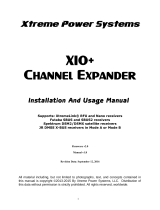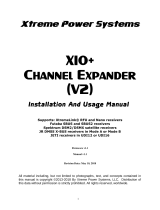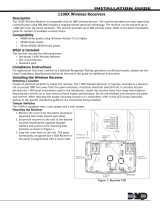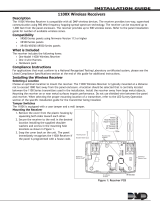Page is loading ...

Xtreme Power Systems
JR11x VERSION
(Internal RF Module Replacement)
Installation And Usage Manual
XtremeLink
®
is a registered trademark of Xtreme Power Systems
Firmware v3.10
Manual v1.0
Revision Date: October 1, 2013
1

All material including, but not limited to photographs, text, and concepts contained in
this manual is copyright ©2007-2013 By Xtreme Power Systems. Distribution of this
data without permission is strictly prohibited! All rights reserved, worldwide.
DUE TO FREQUENT CHANGES, DO NOT POST, UPLOAD, OR
OTHERWISE PROVIDE THIS INFORMATION VIA ANY INTERNET SITE!
Introduction
Thank you for purchasing the XtremeLink
®
system. This system is a direct
replacement for your stock RF module.
Please read through this entire manual before you attempt the installation
and usage of your XtremeLink
®
system!
Installation Requirements
The installation of the XtremeLink
®
RF module is not difficult. If after
reading through this manual, you believe you cannot perform the
installation, please seek someone who can assist you.
This manual should provide ample information and clarity to install and use
this product.
Warranty Information
The XtremeLink
®
system carries a limited lifetime warranty. Units subject to
improper installation, misuse, abuse, crash damage, or modifications will not
be covered under this warranty.
Xtreme Power Systems may at its discretion either repair or replace the unit
covered under warranty. The customer will pay all freight charges to and
from Xtreme Power Systems. Xtreme Power Systems must be contacted to
obtain a return authorization. Any product returned without authorization
will be returned without repair or replacement.
Liability
By using this product, you agree to hold Xtreme Power Systems free from
any type of liability either directly or indirectly while using this product.
2

Legal Information
The ‘look and feel’ and functionality of this product are protected by U.S.
copyright laws. Various terminology and feature names are protected under
U.S. trademark laws.
3

SECTION 1 – INSTALLATION
Step 1 – Removing the stock RF module
Lay your transmitter face down on a towel or something similar to protect it.
Using a thin object like an X-acto blade or flat-tipped screw driver, gently
pry one side of the back cover upwards. Each side of the cover has plastic
tangs the full height of the cover, so it will take some effort to remove the
cover. See Figure 1. Set the cover aside. It is no longer needed. Pull-up
on the entire RF module just enough so that it becomes unplugged from the
transmitter. See Figure 2. Locate the stock RF antenna connector and
carefully remove the connector from the stock RF board by pulling straight
up – not at an angle! DO NOT pull on the coax cable going into the gold the
connector! Remove the entire RF assembly. See Figures 3 through 5 for
details.
4

Figure 1 – Removing the back cover
Figure 2 – Pull up to unplug stock RF module board
5

Figure 3 – Remove antenna connector from the RF board
6

Figure 4 – Remove RF board assembly
7

Figure 5 – Empty RF module location
8

Step 2 – Installing the XtremeLink
®
RF Module
Place the XtremeLink
®
module's plastic case into the empty RF module
location and pass the antenna connector through the hole in the case. See
Figure 6.
Take the XtremeLink
®
RF module and place it at an angle into the plastic
case. Firmly push the antenna connector on to the XtremeLink
®
RF module's
antenna connector port. MAKE SURE that you press this connector straight
down, not at an angle! There should be a definite “snap” feeling when a
proper connection is made. Orient the cable as shown. See Figure 7.
9

Figure 6 – Inserting cable into plastic case
Figure 7 – Attaching antenna cable to XtremeLink
®
RF module
10

With the cable routed properly, position the XtremeLink
®
RF module
completely into the base of the plastic case. See Figure 8.
Figure 8 – Put the XtremeLink
®
RF module fully into plastic case
11

Keeping the case at an angle, take the XtremeLink
®
RF module's lid and
place it over top of the plastic case, making sure that the push button switch
passes through the hole labeled “PROG”. The bottom of the lid has two
tangs that will need to be snapped into the case. With the lid fully over top
of the case, press on the bottom of the lid until it snaps flush with the case.
See Figures 9 and 10 for details.
Figure 9 – Set the lid over top of the plastic case
12

Figure 10 – Apply pressure to snap the lid flush with the case
13

Without removing the plastic case from the module location, carefully rotate
the plastic case and set it in the place. MAKE SURE that the RF cable is not
being pinched. There should be plenty of space for the RF cable to slide
inside of the RF module enclosure as it is rotated. See Figure 11.
Figure 11 – Set module assembly in place
14

Firmly press the module in place. The two large center tangs should lock the
module into the transmitter housing. See Figure 12. Use the two screws
provided to fasten the top of the case. Installation is now complete.
Figure 12 – Module fully seated
15

SECTION 2 – TRANSMITTER MODULE USAGE
After turning on your transmitter, the STATUS LED on the XtremeLink
®
RF
module will begin flashing red. Flashing red means that there is no
connection to an XtremeLink
®
receiver. If the LED does not light up at all,
contact Xtreme Power Systems’ technical support for more information.
When a connection is established, the STATUS LED will light solid green. If
there are telemetry sensors attached to the receiver, the STATUS LED will
flash orange every time telemetry data is received.
Advanced Programming Features
Advanced programming mode allows various features to be changed.
NOTE - Any XtremeLink
®
receiver that has been “bound” to the XtremeLink
®
RF module must be turned off prior to powering on the transmitter.
To enter advanced programming mode, press and hold the PROG button and
then turn on the power to the transmitter. Hold the button until the STATUS
LED changes from off, to green, and then finally to red. This process will
take approximately 7 seconds.
Once you are in programming mode, each time you press and release the
PROG button, the STATUS LED color will change. Below is a table of STATUS
LED colors and their meanings:
STATUS LED FUNCTION
Solid Red Set Power Level
Solid Green Set Hopping Mode
If you press and hold the PROG button while the STATUS LED is any one of
these colors, you will enter the programming for that function.
Additional features will be added in the future.
16

SET POWER LEVEL
Range: 1 to 5
With the STATUS LED solid red, press and hold the PROG button until the
STATUS LED turns off. The STATUS LED will now slowly flash green the
number of times equal to the current power setting. For example, the
default power level is 5, so the STATUS LED will flash green five times.
After the flashing stops you have five seconds to change the power level. To
change the power level, press and release the PROG button one time for
each level of power you would like. For example, if you wanted the power
level to be the lowest possible value, you would press and release the PROG
button just once. If you wanted the power level to be 3, you would press
and release the button three times.
If you do not press the PROG button within five seconds, or if the value you
enter exceeds what is allowed, the STATUS LED will alternately flash red and
green (error condition occurred) and no change will be made. At this point,
you are back at the programming mode start (where you can select a
programming option).
If you do make a change, the STATUS LED will blink green/red/orange in
rapid succession to let you know that the change was successful.
Below is a table of required power levels for various countries.
Country Allowable setting
North America 1-5
Australia & U.K. 1-5
Japan & France 1-2 Hop Mode 1, otherwise 1-5
Europe 1-2 Hop Mode 1, otherwise 1-5
17

SET HOPPING MODE
Range: 1 to 5
With the STATUS LED solid green, press and hold the PROG button until the
STATUS LED turns off. The STATUS LED will now slowly flash green the
number of times equal to the current hopping mode setting. For example, if
hopping mode is currently set to 3, the STATUS LED will flash green three
times.
After the flashing stops you have five seconds to change the hopping mode.
To change the hopping mode, press and release the PROG button as many
times as necessary to equal the hopping mode you would like. For example,
if you wanted the hopping mode to be 3, you would press and release the
button three times.
If you do not press the PROG button within five seconds, or if the value you
enter exceeds what is allowed, the STATUS LED will alternately flash red and
green (error condition occurred) and no change will be made. At this point,
you are back at the programming mode start (where you can select a
programming option).
If you do make a change, the STATUS LED will blink green/red/orange in
rapid succession to let you know that the change was successful.
Below is a table of available hopping modes.
Hopping Mode Setting
Single frequency w/predictive 1
FCC Full Time 2
FCC Full Time w/adaptive 3
ETSI Full Time 4
ETSI Full Time w/adaptive 5
The difference between the FCC and ETSI hopping schemes is the number of
frequencies used. Until this product is re-certified to use more frequencies
(like what has already been done with ETSI testing in Europe), the
frequencies for the U.S. and other FCC compliant countries are same as the
Single frequency w/predictive hopping mode. ETSI hopping increases the
number of frequencies used in hopping sequence.
Note: adaptive mode is still in development and subject to change.
18

SECTION 3 – USING THE SYSTEM
Before the XtremeLink™ system can be used, the XtremeLink™ receiver
must be instructed to communicate only with a single XtremeLink™ RF
module (transmitter). This process, known as “binding” is required only
once, for each new XtremeLink™ receiver.
Binding the XtremeLink™ System
Receiver (8/10 Channel) – Power on your XtremeLink
®
receiver. After a
few seconds the STATUS LED will begin flashing red. Press and hold the
programming button (located inside of the receiver, next to the antenna)
using a 3/32
nd
or equivalent blunt object (note: screwdriver tips will damage
the receiver) until the STATUS LED changes from off to green, and release
the button.
Receiver (Nano) – Power on your XtremeLink
®
receiver and wait for the
STATUS LED to begin flashing red. Now, connect the binding plug to the
port labeled “B”. When the STATUS LED will turns solid red remove the
binding plug. The STATUS LED will then flash red at a different rate,
indicating that it is in binding mode.
Transmitter – Press and hold the PROG button the XtremeLink™ RF module
while powering on the transmitter. Hold the button until the STATUS LED
changes from off to green and then release the PROG button. The STATUS
LED will begin flashing orange. This indicates that the transmitter is waiting
for an XtremeLink
®
receiver to bind to.
Once the button is released, the units should bind. Both STATUS LED on the
transmitter module will turn green when a successful bind has occurred.
YOU MUST power off your transmitter and receiver(s) after binding!
Your XtremeLink
®
system is now ready for use!
NOTES - The XtremeLink® receiver’s STATUS LED will be green
during normal operation if the power level of the transmitter module
is set higher than 1, and red when the power level is set to 1.
19

YOU MUST SET THE HOPPING MODE PRIOR TO BINDING. THE
HOPPING INFORMATION IS TRANSFERRED DURING THE BINDING
PROCESS. IF YOU CHANGE HOPPING MODES, YOU MUST REBIND
ALL RECEIVERS.
MULTIPLE RECEIVER SUPPORT IS NOT AVAILABLE IN HOPPING
MODE 1. ONLY MODES 2-5 SUPPORT MULTIPLE SLAVE RECEIVERS!
*** HOPPING MODES 2-5 WARNING! ***
IF TWO OR MORE RECEIVERS ARE TURNED ON AT THE
SAME TIME, AND THE TRANSMITTER IS THEN TURNED ON,
*ANY* OF THE RECEIVERS MAY LOCK ON TO THE
TRANSMITTER. THE OTHER RECEIVERS WILL NOT LOCK
(UNLESS SET AS A SLAVE).
TURNING ON AND OFF YOUR TRANSMITTER WILL CAUSE
RECEIVERS TO LOCK AND UNLOCK! FOR THIS REASON,
PLEASE MAKE SURE THAT YOUR LAST MODEL IS TURNED
OFF BEFORE FLYING THE NEXT MODEL! ALTHOUGH THIS
IS THE SAME BEHAIVOR AS 35MHz/72MHz AND SOME
OTHER 2.4GHz SYSTEMS, WE ARE LOOKING INTO
SOLUTIONS TO ELIMINATE THIS POSSIBILITY.
20
/










